
John Gutzon de la Mothe Borglum was an American sculptor best known for his work on Mount Rushmore. He is also associated with various other public works of art across the U.S., including Stone Mountain in Georgia, statues of Union General Philip Sheridan in Washington D.C. and in Chicago, as well as a bust of Abraham Lincoln exhibited in the White House by Theodore Roosevelt and now held in the United States Capitol crypt in Washington, D.C.

The Kentucky State Capitol is located in Frankfort and is the house of the three branches of the state government of the Commonwealth of Kentucky. The building is listed on the National Register of Historic Places.

After Abraham Lincoln was assassinated on April 14, 1865, a three-week series of events was held to mourn the death and memorialize the life of the 16th president of the United States. Funeral services, a procession, and a lying in state were first held in Washington, D.C., then a funeral train transported Lincoln's remains 1,654 miles (2,662 km) through seven states for burial in Springfield, Illinois. Never exceeding 20 mph, the train made several stops in principal cities and state capitals for processions, orations, and additional lyings in state. Many Americans viewed the train along the route and participated in associated ceremonies.

Larkin Goldsmith Mead, Jr. was an American sculptor who worked in a neoclassical style.
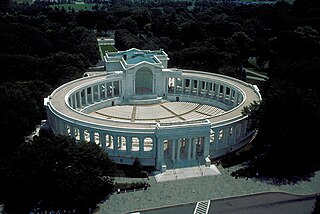
Memorial Amphitheater is an outdoor amphitheater, exhibit hall, and nonsectarian chapel located in Arlington National Cemetery in Arlington County, Virginia, in the United States. It was designed in 1913 as a replacement for the older, wooden amphitheater near Arlington House. Ground was broken for its construction in March 1915 and it was dedicated in May 1920. In the center of its eastern steps is the Tomb of the Unknown Soldier, dedicated in 1921. It has served as the site for numerous Veterans Day and Memorial Day events, as well as for memorial services and funerals for many individuals.

The Victor Emmanuel II National Monument, also known as the Vittoriano or Altare della Patria, is a large national monument built between 1885 and 1935 to honour Victor Emmanuel II, the first king of a unified Italy, in Rome, Italy. It occupies a site between the Piazza Venezia and the Capitoline Hill. The monument was realized by Giuseppe Sacconi.

George Rogers Clark National Historical Park, located in Vincennes, Indiana, on the banks of the Wabash River at what is believed to be the site of Fort Sackville, is a United States National Historical Park. President Calvin Coolidge authorized a classical memorial and President Franklin D. Roosevelt dedicated the completed structure in 1936.

The United States Capitol building features a central rotunda below the Capitol dome. Built between 1818 and 1824, the rotunda has been described as the Capitol's "symbolic and physical heart".

The Civil War Memorial, in the DeKalb County county seat of Sycamore, Illinois, United States, is located in front of the DeKalb County Courthouse on a public square. The memorial was erected in 1896 and dedicated in 1897. The structure is a memorial to the thousands of DeKalb County residents who served in the American Civil War. It incorporates an obelisk which rises to 50 feet in height. The base is adorned with copper sculpture, completed by an unknown sculptor. On the east facade of the memorial the word "Antietam", denoting the Battle of Antietam, is misspelled. This work of public art underwent its first restoration work in 2005-2006.
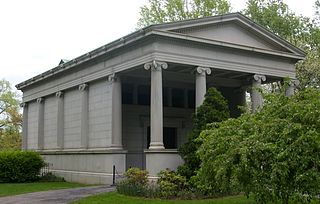
Wade Memorial Chapel is a Neoclassical chapel and receiving vault located at Lake View Cemetery in Cleveland, Ohio, in the United States. It was donated to the cemetery by Jeptha Wade II in memory of his grandfather, cemetery and Western Union co-founder Jeptha Wade. The overall design was by the newly-founded Cleveland area architectural firm of Hubbell & Benes, and was their first commission. The interior's overall design is by Louis Comfort Tiffany based on a preexisting 1893 design. The interior features two mosaics on the right and left hand walls, and a large stained glass window.
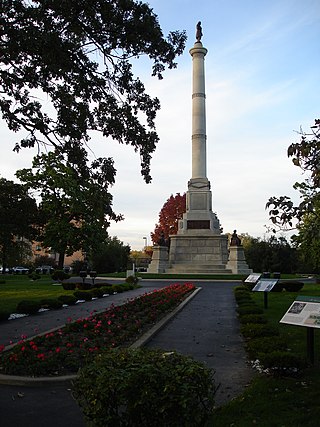
The Stephen A. Douglas Tomb and Memorial or Stephen Douglas Monument Park is a memorial that includes the tomb of United States Senator Stephen A. Douglas (1813–1861). It is located at 636 E. 35th Street in the Bronzeville neighborhood of Chicago, Illinois, near the site of the Union Army and prisoner of war Camp Douglas. The land was originally owned by Douglas’ estate but was sold to the state of Illinois, when it became known as “Camp Douglas” serving first as training grounds for Union soldiers during the Civil War, then as a prisoner of war camp.
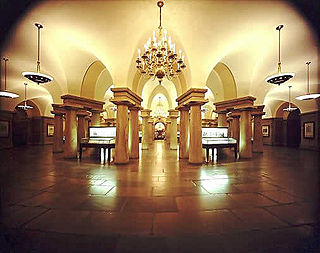
The United States Capitol crypt is the large circular room filled with forty neoclassical Doric columns directly beneath the United States Capitol rotunda. It was built originally to support the rotunda as well as offer an entrance to Washington's Tomb. It currently serves as a museum and a repository for thirteen statues of the National Statuary Hall Collection.
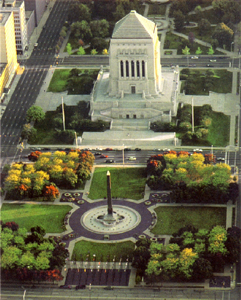
The Indiana World War Memorial Plaza is an urban feature and war memorial located in downtown Indianapolis, Indiana, United States, originally built to honor the veterans of World War I. It was conceived in 1919 as a location for the national headquarters of the American Legion and a memorial to the state's and nation's veterans.

The Palatinal Crypt in Buda Castle, Budapest is the burial place of the Hungarian branch of the Habsburg dynasty, founded by Archduke Joseph, Palatine of Hungary. It is the only interior part of Buda Castle which survived the destruction of World War II and was not demolished during the subsequent decades of rebuilding.

The Monumental Cemetery of Bonaria is located in Cagliari, Sardinia. In use between 1829 and 1968, this monumental cemetery originally occupied an area at the base of the hill of Bonaria, and over time expanded upwards. The main entrance is located in Piazza Cimitero, with a second entrance in Ravenna, at the Basilica of Bonaria. Several famous people were buried in Bonaria, including the canonical archaeologist Giovanni Spano, the tenor Piero Schiavazzi and General Carlo Sanna.
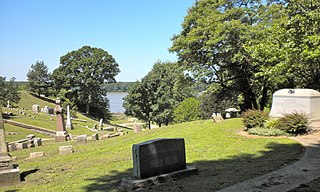
Woodland Cemetery is a historic cemetery located at 1020 South Fifth Street in Quincy, Illinois. Planned by politician John Wood and opened in 1846, the cemetery is a product of America's rural cemetery movement of the mid-nineteenth century. The cemetery's grave markers include smaller Victorian monuments and large Gothic Revival and Neoclassical structures. The cemetery was added to the National Register of Historic Places in 2002.

The Oklahoma Judicial Center is the headquarters of the Oklahoma Supreme Court, the Oklahoma Court of Criminal Appeals, and the Judiciary of Oklahoma. Situated near the Oklahoma State Capitol, the original structure, designed by the architectural firm Layton, Hicks & Forsyth, was built between 1929-1930 as the home of the Oklahoma Historical Society and was listed on the National Register of Historic Places as the Oklahoma Historical Society Building in 1990. The society moved to the nearby Oklahoma History Center when it opened in 2005. An annex was completed in 2011.

A colossal bust of Abraham Lincoln was made by Gutzon Borglum and completed in 1908. The original marble sculpture is installed in the United States Capitol crypt, in Washington, D.C. Reproductions cast in bronze are installed in several other locations, including the Lincoln Tomb in Springfield, Illinois.

























